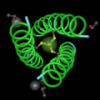Ribosomes are molecular machines that build new proteins. This process of synthesizing a protein is also known as translation.
Many antibiotics prevent translation by binding to ribosomal RNA. In the class that I'm teaching, we're going to be looking at ribosome structures to see if the polymorphisms that we find in the sequences of 16S ribosomal RNA are related antibiotic resistance.
This is related to our metagenomics project where we investigate the polymorphisms we find in 16S ribosomal RNAs.
This 6 minute video introduces ribosomes, discusses where they're found, what they're made of, how they're built, and discusses why some parts of the ribosome might be under less selective pressure than others.
Meet the ribosomes from Sandra Porter on Vimeo.

I prefer to say that ribosomes are an important component of the translation machine. In addition to ribosomes, the translation machine includes mRNA, aminoacyl-tRNAs, and several kinds of initiation, elongation, and termination protein factors. The idea that ribosomes alone make proteins is not correct and I think it's more than a quibble to insist that aminoacyl-tRNAs and the translation factors be included.
I like tRNAs, without them the ribosomes wouldn't have any amino acids to put together.
And I think tRNAs deserve their own video.
I like ribosomes. The entire nucleus machinery is a wonder and a testament to an ingenious invisible power at work